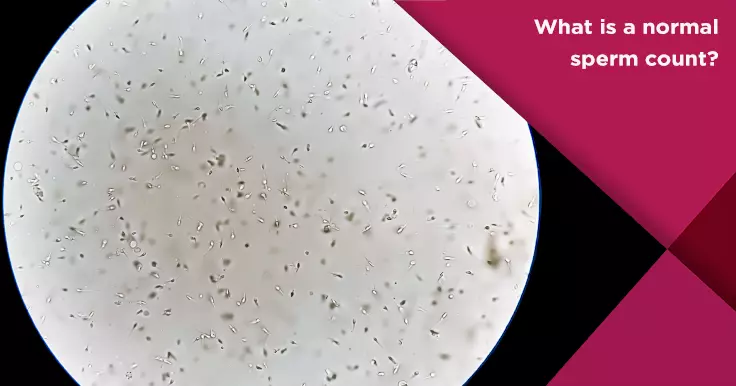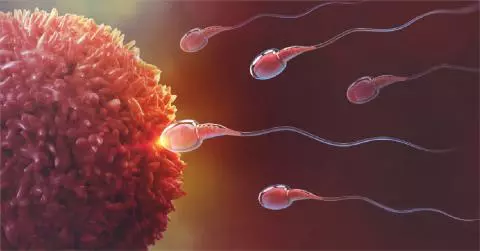What is a Normal Sperm Count?

Male fertility is as important as female fertility when you are thinking of building a family; it is quite complex as well. The quality and quantity of sperm produced by a male plays an extremely important role in male fertility. Sperm health is determined by various factors and sperm count is one of them.
This article explores the aspect of sperm count in male fertility. Keep reading to learn more about the normal sperm count.
What Does Normal Sperm Count Mean?
Sperm count refers to the number of sperms that should be present in a given sample of ejaculation. Normal sperm count usually ranges from 15 million sperm/mL of semen to more than 200 million sperm/mL of semen.
Low sperm counts
According to the WHO, 10-15 million sperm per millilitre is classified as lower than the normal range. Although it takes only one sperm to fertilise the ovum, higher quantities of sperm increase the probability of the sperms to successfully reach the egg. Low sperm count can still achieve pregnancy if other factors of sperm health are normal. There are also treatments and changes that one can do to improve the count.
Sperm count less than 15 million per millilitre is the low Average range. This implies that your count is not exactly in the lowest range but it still below average.
More than 15 million sperm per millilitres is considered to be the average sperm count range. Having numbers in this range denote that your chances of getting pregnant in the first few attempts are 50-50, provided all other parameters of sperm health are good.
High sperm counts
Some institutes consider ≥300 million sperm/mL as a high sperm count. However, according to research if a male’s sperm count reaches higher than 40 million/mL, it does not translate to increased fertility. Thus, it is safe to say that the number of sperms does not factor in with respect to increase fertility rates when they are higher than 40 million sperm/mL.
What is the importance of sperm count?
Although it takes a single sperm for the fertilisation of the egg, a health sperm count is often necessary to conceive naturally. The number of healthy sperm in your ejaculation increases your partner’s chances of conception.
Apart from conception, a healthy sperm count is a significant measure of your overall health. Research has found that men who have a low sperm count are more susceptible to have a high body fat percentage and blood pressure than men who have a high sperm count. Men who have low sperm count also experience a higher chance of developing chronic disorders such as diabetes, heart diseases, and stroke.
Understand your semen analysis
With a simple semen analysis, one can know their sperm count as well as several other factors, including the following:
Morphology
This parameter is used to evaluate the size and shape of the sperm, as they can affect the fertility of the male. Although all semen samples contain abnormally shaped sperm, high number of abnormally shaped sperm in semen increase the likelihood of infertility.
Motility and velocity
These measure the speed and ability of the sperm to swim in order to fertilise an egg.
pH
This measures the acidity or basic of the semen. The average pH of semen is 7.2-7.8. A high pH can be indicative of infection an infection, and a low pH can indicate contamination of the sample or an obstruction in the reproductive system.
Liquefaction
The ability of semen to change from gel to liquid state is known as liquefaction. If the semen does not liquify in about 15-20 minutes, it gravely impacts the ability of the sperm to travel up the uterus and fertilise an age.
Total semen volume
As the name suggests, this measures the total amount of the semen ejaculated by a person. Generally, males ejaculate about 2 to 5 mL of semen; if your semen analysis indicates low amount of semen, your doctor may need to examine your prostate gland for seminal vesicle problems. If it indicates high amount of semen, it indicates low sperm concentration.
Semen analysis results table
Here are the normal results of semen analysis according to the World Health Organization.
| Parameter | Reference Ranges from WHO |
| Total sperm count in ejaculate | 39-928 million |
| Ejaculate volume | 1.5-7.6 mL |
| Sperm concentration | 15-259 million/mL |
| Total motility (progressive and non-progressive) | 40-81% |
| Progressive motility | 32-75% |
| Sperm morphology | 4-48% |
Are there any treatment options for low sperm count?
Yes, there are certain treatment options to address low sperm count in men.
Factors like your genetics, sexually transmitted diseases (STDs), general health, and past surgeries influence your sperm count. After recommending a semen analysis, your doctor may recommend any of the following treatment options:
- Surgery: Males who have varicocele or obstruction in the vas deferens, your doctor may recommend surgery as an option to correct or repair your reproductive function.
- Antibiotics: If the cause of your low sperm count or infertility is a bacterial infection, then a course of antibiotics may be recommended for your treatment.
- Counselling or medication: Males who are experiencing erectile dysfunction, premature ejaculation, or other problems with sexual intercourse can benefit from medication or counselling.
- Treatment with hormones: Males who have hormonal imbalance leading to infertility can benefit from treatment with hormones.
How to improve your sperm count?
The good news is that a normal sperm count can be achieved through basic changes in diet and/or lifestyle. This promotes the overall male fertility health. Some of these changes include:
- Exercising regularly
- Refraining from alcohol consumption, smoking and drugs.
- A balanced diet, cutting out processed foods.
- Having intercourses in the mornings since the sperm count is the highest then.
- Avoid wearing tight underwear
- Taking vitamin C and vitamin E supplements which are antioxidants crucial for sperm health.
Be sure to consult a doctor if you think low sperms count is creating fertility issues.
Male Fertility Beyond Numbers
Sperm count is the key factor in male fertility, but numbers are not everything. Sperms must have the normal shape of an oval head, a mid-piece, and a tail. They should also be able to swim in a straight, forward direction to easily reach the egg. All these three fundamental parameters of sperm health must be normal and work together naturally for the process of fertilising the ovum.
If you think you might have a low sperm count, consider consulting with a fertility expert near you to help you achieve your dream of building a family.
 Infertility Counselling
Infertility Counselling Female Infertility Treatment
Female Infertility Treatment Andrology Treatment
Andrology Treatment Fertility Enhancing Surgeries - Female
Fertility Enhancing Surgeries - Female Fertility Enhancing Surgeries - Male
Fertility Enhancing Surgeries - Male Endoscopy Treatment
Endoscopy Treatment IUI Treatment
IUI Treatment IVF Treatment
IVF Treatment ICSI Treatment
ICSI Treatment Advanced IVF Solutions
Advanced IVF Solutions Embryology
Embryology Vitrification Egg, Embryo, Sperm Freezing
Vitrification Egg, Embryo, Sperm Freezing Preimplantation Genetic Testing (PGT)
Preimplantation Genetic Testing (PGT) Donation Program Embryo / Egg / Sperm
Donation Program Embryo / Egg / Sperm Self-cycleTM IVF
Self-cycleTM IVF

 Self-cycleTM IVF
Self-cycleTM IVF










